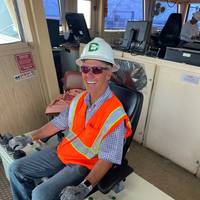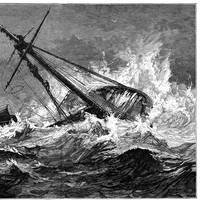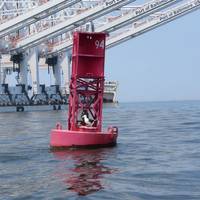Interview: Harry Stewart, President & CEO, The Dutra Group

Harry Stewart recently took the helm as President and CEO of The Dutra Group, succeeding Bill T. Dutra, the man who founded the company at the age of 26 and led it for the last 50 years. With a renewed vigor for national infrastructure, there are myriad opportunities in the dredging and marine construction sectors, opportunities balanced by a similar number of challenges. We recently visited with Mr. Stewart for his insights, covering everything from taking over the seat from an industry legend…
Port of Oakland Gets Giant Cranes
SSA Terminals, the operator of Oakland International Container Terminal, submitted last week a $30 million order for three 300-foot-tall gantry cranes, which are expected to be delivered in 18 months.The cranes will go to Oakland International Terminal on Oakland Estuary and will become the tallest on the West Coast, port officials said.The project aims to prepare the port to handle the world's largest container ships, which can be up to 1,300 feet long and carry nearly 23,000 cargo containers. The containers can be stacked up to 12-high above deck on the largest vessels, officials said.“This demonstrates the faith that business partners have in Oakland as a trade gateway,” said Port Maritime Director John Driscoll.
Port of Oakland Completes TraPac Terminal
Port of Oakland’s container terminal operator, TraPac, concluded a USD 67 million waterfront expansion in January 2019 as it opened a new vessel berth to arriving container ships.The milestone signals completion of a two-year project at Oakland’s second-largest terminal that has nearly doubled TraPac’s footprint from 66 to 123 acres; boosted its fleet of ship-to-shore cranes from four to seven; and added a third 1,400-foot-long dock for berthing mega containerships.“We are grateful to dockworkers, truckers, carriers, cargo owners and all of our stakeholders for working with us during this buildout,” said TraPac Operations Vice President Brian Bauer.
Avoiding the Edges of the Sea

Mariners do best when they avoid the edges of the sea – the shoals, rocks, and other hard spots. Coming into contact with the edges of the sea at other than a slow walking speed can ruin an otherwise pleasant voyage. Unfortunately, though, vessels have been making hard contact with the edges since Noah’s Ark grounded on Mount Ararat, rendering the Ark unseaworthy. For a while, it was thought that the leadline would reduce groundings, but one can’t be swinging the leadline constantly. Lighthouses were another early means of identifying hard spots by means other than direct contact.
USCG Testing eATON in San Francisco Bay

The U.S. Coast Guard (USCG) said it is now testing 25 electronic aids to navigation (eATON) to augment existing physical aids and mark unique and potentially hazardous navigation features in the San Francisco Bay Area. Commonly referred to as “virtual” buoys, the eATON are being transmitted through the Coast Guard’s Nationwide Automatic Identification System (NAIS) for display on ships’ electronic charting systems and radars. As part of ongoing efforts to increase the safety of navigation on the Bay the Coast Guard…
America's First 'Virtual' Aids to Navigation on Test
The Coast Guard informs it is now testing 25 electronic aids to navigation (eATON) to augment existing physical aids and mark unique and potentially hazardous navigation features in the San Francisco Bay Area. Commonly referred to as “virtual” buoys, the eATON are being transmitted through the Coast Guard’s Nationwide Automatic Identification System (NAIS) for display on ships’ electronic charting systems and radars. It is explained that as part of ongoing efforts to increase the safety of navigation on the Bay the Coast Guard, in close consultation with waterway users, identified multiple offshore and inshore locations to deploy the eATON.
Veteran Maritime Attorney Changes Sides

George M. Jones joins Los Angeles Maritime Law offices of Charles D. Naylor. An experienced trial attorney, Mr. Jones brings to the firm more than 20 years of maritime law experience. “I’ve known George for almost 20 years, and amongst fellow maritime lawyers, he has a reputation for being one of the best – for his legal expertise, character and integrity,” said maritime attorney Charles D. Naylor. At the Law Offices of Charles D. Naylor, Mr. Jones is leading the firm’s Longshore and Harbor Workers’ Compensation Act (LHWCA) claims team…
Overseas Reymar Cleared to Sail; Investigation Continues
Overseas Reymar cleared to sail; Coast Guard Calls on Harbor Safety Committee to review Critical Maneuvering Areas; investigation continues. The U.S. Coast Guard has completed interviews, evidence collection, and a thorough safety inspection onboard the oil tanker Overseas Reymar which has been anchored in San Francisco Bay’s Anchorage 7 since the vessel’s allision with a support tower of the San Francisco-Oakland Bay Bridge Monday morning. Coast Guard inspectors and representatives from the vessel’s Flag State have determined the Overseas Reymar is safe to sail. This determination was based on a careful assessment of the vessel’s structural damage, and the inspection and testing of critical propulsion, auxiliary, navigation, safety, and environmental protection systems.
NTSB to Investigate SFO Allision

NTSB investigating allision between oil tanker and San Francisco-Oakland Bay Bridge. The National Transportation Safety Board today announced it is investigating an allision Monday between the oil tanker Overseas Reymar and one of the supports of the San Francisco-Oakland Bay Bridge. The NTSB named Barry Strauch the investigator-in-charge. Strauch will coordinate with the U.S. Coast Guard, which classified the accident today as a "major marine casualty," because the incident exceeded the threshold of more than $500,000 in property damage.
Container Ship Owner Sues Pharmacists
The owners and operators of a container ship that slammed into the San Francisco-Oakland Bay Bridge in 2007 and spilled thousands of gallons of oil into San Francisco Bay have sued the Northern California pharmacists they claim negligently dispensed prescription drugs to the pilot of the Cosco Busan, according to news in 'The Washington Post'. The ship’s owner, Regal Stone Ltd., and operator Fleet Management Ltd. Alleged in court papers filed in San Francisco Superior Court Friday that the pills “recklessly” provided by pharmacists at a Longs drug store in Petaluma, Calif. had so clouded pilot John Cota’s judgment and dulled his reflexes that they led to the crash.
$44 Million Settlement in 2007 San Francisco – Oakland Bay Bridge Crash and Spill
Oil Spill Proceeds Of Settlement to Fund Projects and Restore Natural Resources Largest Oil Pollution Act Settlement in History of the Law. Federal, state and Bay-area officials announced a comprehensive civil settlement with the owners and operators of the M/V Cosco Busan, resolving all natural resource damages, penalties and response costs that resulted from the ship striking the San Francisco-Oakland Bay Bridge in 2007, and subsequent oil spill in the San Francisco Bay. The event killed thousands of birds, impacted a significant portion of the Bay’s 2008 herring spawn, spoiled miles of shoreline habitat and closed the bay and area beaches to recreation and fishing. The U.S.
Multiple Factors Caused Container Ship Accident
The National Transportation Safety Board determined on Feb. 18 that a medically unfit pilot, an ineffective master, and poor communications between the two were the cause of an accident in which the Cosco Busan container ship spilled thousands of gallons of fuel oil into the San Francisco Bay after striking a bridge support tower. On November 7, 2007, at about 8:00 a.m. PST, in heavy fog with visibility of less than a quarter mile, the Hong Kong- registered, 901 ft container ship M/V Cosco Busan left its berth in the Port of Oakland destined for South Korea. The San Francisco Bay pilot, who was attempting to navigate the ship between the Delta and Echo support towers of the San Francisco-Oakland Bay Bridge…
CA Files Suit Against Cosco Busan
California Attorney General Edmund G. Brown Jr. filed a lawsuit today on behalf of the California Department of Fish and Game Office of Spill Prevention and Response, State Lands Commission and State Water Boards against the owners, operators and pilot of the M/V Cosco Busan, the shipping vessel that spilled more than 53,000 gallons of oil into San Francisco Bay. “This was a preventable accident that had tragic consequences,” Attorney General Brown said. On November 7, 2007, the Cosco Busan, piloted by John Cota, hit the San Francisco-Oakland Bay Bridge’s Delta Tower. The crash caused approximately 53,569 of gallons of oil to spew into San Francisco Bay and spread to the Pacific Ocean and along Bay Area shorelines.
Cummings Convenes Hearing on Inspector General’s Report Concerning COSCO BUSAN
Congressman Elijah E. Cummings convened the Subcommittee on Coast Guard and Maritime Transportation to receive a report developed by the Department of Homeland Security’s Office of the Inspector General (OIG) on the circumstances surrounding the allision of the COSCO BUSAN with the San Francisco-Oakland Bay Bridge on November 7, 2007. This report was originally requested by the Speaker of the House of Representatives, Nancy Pelosi, and Chairman Cummings following a hearing of the Subcommittee convened in last November to begin examining this incident. “Among other results, the OIG found that five of the six individuals assigned as marine casualty investigators in Sector San Francisco were unqualified for these positions.
Initial Report on Cosco Busan Incident Prepared
The Coast Guard issued a press release stating that the initial report on the COSCO BUSAN incident has been prepared and forwarded to Headquarters for review. The report, prepared by the Incident Specific Preparedness Review (ISPR) team, focuses on the first two weeks of the response to the November 7, 2007 allision of the freighter with a pier of the San Francisco-Oakland Bay Bridge and the ensuing oil spill. Public release of the report is expected in approximately two weeks. source: HK Law
USCG Allows Cosco Busan to Depart
The Coast Guard has authorized the COSCO BUSAN to resume maritime commerce. The customs hold and all orders requiring the vessel to remain in San Francisco issued by the Captain of the Port have been lifted. Required temporary repairs to the vessel have been completed, the vessel and crew have been verified safe to sail, and the vessel operator has provided a satisfactory load plan for cargo operations. Earlier issues regarding operation of the ship that were of concern have been addressed by the vessel's owner to the Coast Guard's satisfaction. The Coast Guard Captain of the Port previously directed the master of the COSCO BUSAN to keep the ship in port in order to ensure the vessel's seaworthiness…
San Francisco on Oil Spill: Sue Everyone

Two Coast Guard small boats set a security zone around the 900-foot container ship Cosco Busan. The ship hit the San Francisco Bay Bridge Nov. 7, 2007 spilling an estimated 58,000 gallons of oil into the bay.(U.S. City Attorney Dennis Herrera filed suit in San Francisco Superior Court, under the State's Lempert-Keene-Seastrand Oil Spill Prevention and Response Act and other state laws, against the parties responsible for the November 7 oil spill incident in the San Francisco Bay. In that incident, the M/V Cosco Busan, a 65,131-ton, 900-ft.





